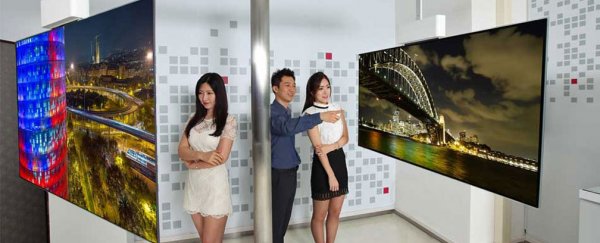Arguments about what to watch on television could soon become a thing of the past – provided you've got a big enough living room, two couches, and you don't mind having to take turns with the remote control.
LG has shown off prototypes of what are believed to be the world's first double-sided OLED (organic light-emitting diode) displays at the IFA 2015 consumer electronics show in Berlin, Germany. Two separate models – one measuring 281 centimetres (111 inches) diagonally, and the other 139 cm (55 inches) – allow viewers to watch entirely different content on the alternate sides of the panel, potentially introducing a dramatically new way that people could use their televisions in the near future.
Of course, this kind of thing would have been possible before by simply sticking any two flat panel TVs back-to-back, but what's so impressive about LG's prototypes is just how thin the double-sided displays are. The 139 cm model seen in the picture above is only 5.3 mm thick – more than 25 percent thinner than an iPhone 6 (which, if you weren't aware, is already pretty thin).
Truth be told, the larger 281 cm prototype achieves its gargantuan display size by cheating a little bit – it's actually three separate 165 cm (65 inch) displays stuck together side-by-side. Other companies have made similar giant displays before using similar methods, but none of them could be watched from opposite sides of a room like this.
LG has been able to achieve such super-thin profiles by using OLED displays instead of conventional LCD technology. Currently OLED displays are significantly more expensive to produce than LCD screens but their advantages over LCD are also numerous: they enable screens to be literally wafer-thin and flexible, and they also produce richer blacks than the lighter greys LCD displays show.
A good example of just how thin OLED displays can get is in this video by Digital Trends. It not only shows off the slim profile of the double-sided display but also another prototype LG model that the company is calling "wallpaper": an amazingly svelte 1-mm-thick (!) display that can be instantly placed wherever you like on walls via magnetic backing. Woah.
Since these are only prototypes, release dates and pricing have yet to be announced. And it's more than likely that the double-sided screen at least has primarily been developed for signage and display purposes rather than as a device people would bring into their homes. But who knows? With the possibilities of such super-thin screens on offer, we'd have to say the future of TV is looking pretty great right now.
